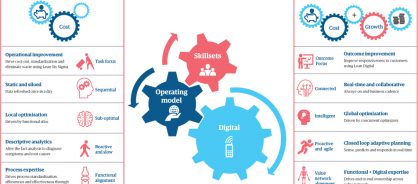- Blog
The cognitive supply chain: Why your firm needs one
And how the persuasive power of digital nudging can help

Increasing customer expectations around service and personalization are adding significant complexity and uncertainty to global supply chains. Supply chains now need to be highly responsive, agile, and flexible if they are to live up to the C-suite's growth agenda. This calls for seamless collaboration between supply chain partners, real-time visibility into risks and opportunities, and closed-loop adaptive planning.
We've already made progress in these areas. Technological advancements such as the internet of things (IoT), the cloud, and big data have turbocharged supply chains. With the influx of data and digital technologies, supply chain management is at a tipping point. It is now possible to capture, store, process, and share data in real time to make faster and more effective decisions. The next big development is a shift away from transactional to cognitive supply chains – these are the supply chains of the future.
What is a cognitive supply chain?
The cognitive supply chain differs from its transactional predecessor significantly. A cognitive supply chain will be digitally-led and process-centric – as opposed to being merely digitally enabled. This new model is already evolving as digital technologies with embedded analytics converge to capture, store, process, and share data. Scalable, more flexible operating models, as well as new skill sets, are natural enablers of this evolution.
How to accelerate to a cognitive supply chain
The transition is exciting and aspirational, but it isn't easy . It requires change management at every level and impacts operating models, skill sets, and the digital tools required to power it. By driving exception-based issue resolution, for example, companies can establish processes and systems that foster greater productivity. And in a world of information overload, eliminating noise from signals can promote insights and encourage meaningful actions that lead to improvements.
One way to manage change quickly is through digital nudging. The concept owes its origin to behavioral economists, who believe that with subtle encouragement—so-called nudges—they can direct people's decisions. Digital nudging uses technologies to do the same thing at scale. Here are some supply chain examples:
- Planners get real-time alerts on service risks to enable prompt decision making
- Planners get daily priority lists that highlight critical exceptions
- Before planners start their day, LED screens indicate if overnight scheduled jobs have run and data is up to date
- Real-time, role-based visualizations show critical measures such as inventory outside-tolerance limits, safety stock gaps, master-data quality, and audit compliance
- Automated root-cause assignments of service misses and excess inventory encourage meaningful actions
Figure 1: The evolution from a transactional to cognitive supply chain

Key enablers of a cognitive supply chain
As seen in figure 1, three factors will power the transition to a cognitive supply chain:
- Digital technologies, including the IoT, big data, the cloud, blockchain, and bots. These help collect, store, process, and share information securely across the value chain. Also, coming into play: artificial intelligence, machine learning, cognitive analytics, and techniques that learn patterns and context from structured and unstructured data to get the best possible outcomes
- Skill sets are evolving from functional expertise to functional-plus-digital expertise
- Operating models that evolve from decentralized and shared services centers to scalable hybrid global business services with global, regional, and local centers pushing cost, service, and cash goals
Why does a cognitive supply chain matter to you? Customer delight.
- It focuses on outcomes. It can reduce the order-to-ship cycle time from three days to less than a day, for example. By contrast, transactional supply chains tend to focus on cutting costs
- It's connected, allowing suppliers, customers, third-party manufacturers, and logistics providers to collaborate in real time to purchase, produce, and move exactly what the end consumer needs
- It's an intelligent supply chain, with embedded business logic for end-to-end optimization and decision making, as opposed to local optimization. For example, deployment recommendations will not just consider demand-side priorities, but also costs (transportation and penalty cost) and capacity (warehouse and transportation)
- It proactively responds to real-time demand signals from points of sale so the business can change short-term forecasts, marketing campaigns, or production schedules
Where can you begin?
The nature of this journey will depend on organizational maturity across several areas. The best place to begin depends on:
- Accuracy and reliability of data used in decision making
- Level of process standardization, integration, and automation
- How advanced the organization is in embedding digital across the enterprise
- Time needed for the data-to-insight conversion process – which typically includes tasks like extraction, processing, interactions, meetings, and exception management
- Employee attrition levels and the operating model (e.g. decentralized operations or a shared services center)
Here's what makes the move worth it
The benefits of moving from a transactional to cognitive supply chain include faster time-to-market, improved market share, and increased growth and profitability. As metric outcomes, you can expect to see:
- 50% improvement in productivity
- 70% reduction in excess or unproductive inventory
- 8% year-on-year reduction in logistics costs
- 40 percentage point improvement in forecast accuracy
- 15 percentage point improvement in customer service
How Genpact can help
Genpact is a leader in cognitive supply chain management. Our ready-to-deploy global business services and digital transformation framework can help you design a personalized target operating model and show you the digital interventions you'll need to accelerate your journey.
